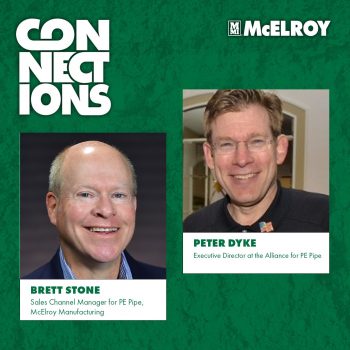
Tyler Kern tapped two true subject matter experts to explore the role PE pipe plays in today’s world of infrastructure and its uses in many different applications.
Peter Dyke, Executive Director at the Alliance for PE Pipe, and Brett Stone, Sales Channel Manager for PE Pipe at McElroy Manufacturing, were thrilled to get the opportunity to speak about the many benefits and use cases of this versatile piping material.
One question Dyke gets a lot is, why does the Alliance for PE Pipe exist? The quick answer is education.
“We exist to educate people about the market,” Dyke said. There is a considerable knowledge gap in people’s awareness and understanding of the technology offered by polyethylene pipes. “It’s a great mission. It’s an intellectual sell to the engineers, but it’s also a demonstration sell to the guys working in the field.”
“It performs the best, it fails the least, and it has the most minimal impact on the citizenry during construction than all the other pipe types.”
Peter Dyke
With its B2B focus, Dyke said the Alliance’s market focus for PE pipe is on municipalities, civil engineers and contractors.
What makes PE piping the best product of its kind? “It’s the longest-lasting, lowest-priced conveyance product on the market,” Dyke said. “It performs the best, it fails the least, and it has the most minimal impact on the citizenry during construction than all the other pipe types.”
If PE piping is the best, doesn’t it cost more than other solutions?
“We cost a third to a half less than ductile iron, yet we perform hundreds of years more,” Dyke said. “We have solved the typical failure mechanism of PVC and ductile iron.”
While the benefits may be plenty, getting the word out about PE piping is still an undertaking. Still, it’s a mission Dyke and the Alliance are happy to undertake.